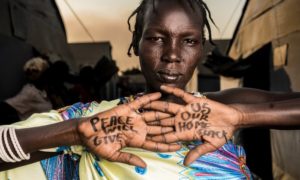To what extent does the idea of ‘bearing witness’ apply to aid workers (both international and national) in places like Sudan, Syria, Iraq, Afghanistan, and Yemen? To what extent should aid workers tell or not tell the stories those in the affected communities to their friends and family? On Facebook or other social media?
The question of whether or not it is our duty to share stories of affected communities ties into the idea of the humanitarian imperative. Is it our responsibility to showcase others’ suffering and vulnerability? This question has many layers. If the suffering and struggles that people go through is not brought to light, how can make people aware and attempt to help them? But then there is a question of what is appropriate to share and what is not.
I found the section in That the World May Know about storytelling to be extremely interesting and eye-opening to help understand the depths of these questions. Dawes describes the perspective of writer and journalist David Rieff as he describes that aid workers tell stories for various types of reasons. Some tell stories to draw attention to a crisis they have encountered in order to get some sort of remedy. Some to denounce bad behavior and motivate intervention, either political or military. Lastly some tell stories to publicize their own organization’s work. The story is merely a vehicle for more publicity and continuing a specific type of work (165). This ties back to the idea of to the idea of Social Exchange Theory in that humans don’t typically give without expecting something in return, (SOC376: 2/13/19). Thus, while some aid workers may tell these stories in order to help the affected communities they have seen, there is some level of ulterior motivation which could be trying to paint themselves in a certain light or draw attention to their organization.
Aside from the motivations of the aid workers themselves comes the effects that these stories can have on the people they are about. As Dawes includes in this novel, “Who nominates you to publicize pain and suffering that you can walk away from?” (166). Dawes discusses another incident in which a photographer described not being able to photograph a situation in which Bihari prisoners were being tortured and killed. However, the other photographers he was with continued to do so and “enticed the killers.” (168). This story stuck out to me as it gives the torturers exactly what they wanted—attention. The same goes for mass shootings when the killer often times commits the crime in order to get their name out and be in the news. If aid workers tell stories like these about atrocities they have witnessed they are thus giving credit to the perpetrator rather than the victim. By writing about these faceless victims, the author thus condemns the entire group to one single body. (197). Another effect that these stories can have on the affected community is the sheer problem of having to relive those difficult times. By publicizing and telling these stories whether it be via social media or in a book, these people are forced to relive their pain again. It is crucial in this sense to take informed consent from the individual and avoid putting one’s own language and feelings into the story. These people also may be scared, ashamed, or worried about the consequences of sharing their stories so it is important to respect their freedom of silence, (Ghaoui 2016).
To not tell of the tragedies that occur in places other than our home is not a question. These stories must be brought to light in some way, shape, or form. Shedding light on injustices sparks reform and intervention and helps the affected people and communities. However, the way that these stories are told needs to be monitored. Aid workers may believe that it is their duty and responsibility to tell every detail of what they of they encounter. This goes along with the White-Savior industrial complex which we have discussed. Cole states that “those who are being helped ought to be consulted over matters that concern them” (Cole). Thus, the people who these stories are being told about should be informed of the possible outcomes and should be able to have a clear voice. Some believe that some stories may be too gruesome and violent to share with the public and often times situations are covered up. In the book that I read called Where Soldiers Fear to Tread a UN volunteer ends up killing a woman during a protest in Somalia. The situation was put to rest and not told out of fear that it would reflect poorly on the UN. This goes back to the question of whether or not all stories should be told and whether or not it is our duty to tell them knowing possible consequences.
This is a photo of a woman named Mary from South Sudan posing for a photo to raise awareness and funds for affected people in her community.
Cole, Teju. “The White-Savior Industrial Complex.” The Atlantic, 21 Mar. 2012.
Dawes, James. That the World May Know: Bearing Witness to Atrocity. Harvard University Press, 2007.
Ghaoui, L. (2016). “How to Tell Humanitarian Disaster Stories Responsibly.” The Guardian. Aug. 2016
SOC 376: “Being/Becoming a Global Citizen” (SOC 376: 2/13/19)


One Trackback
… [Trackback]
[…] Read More here: blogs.elon.edu/soc3711903/?p=3856 […]